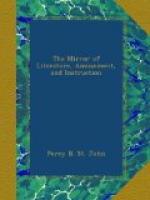It has been stated that Mr. Burford, the successful painter of Stirling, is engaged on a Panorama of the Falls of Niagara. All admirers of this style of painting must be anxious for his success.
* * * * *
SIR WALTER SCOTT.
Mr. Parker has issued in addition to the Medal already noticed in our pages, a Medallion of the lamented Poet and Novelist, from Chantrey’s bust. It is, we think, the obverse of the Medal, with bronzed circular frame work bearing the motto suggested by Sir Walter. Though handsome, it is an economical memorial of one whose amiable talents must endear him to every fireside in the kingdom.
* * * * *
NEW BOOKS.
* * * * *
POMPEII.
[The second and concluding volume of the descriptive history of Pompeii, in the Library of Entertaining Knowledge, is still more attractive than its predecessor. It contains the very domestic economy of the ancient inhabitants—chapters on domestic architecture, paintings and mosaics, streets and fountains, private houses, villas, and tombs; and, moreover, on the art of baking, and the forms of domestic utensils. We are, therefore, led through hall, parlour, bath, kitchen, and shop, with amusing minuteness; and, in the account of furniture and domestic implements, it is curious to observe, how far we are indebted to the ancients for the forms of similar contrivances now in use. One of the best passages in this portion of the work is the following, on the]
Lamps and Candelabra.
No articles of ancient manufacture are more common than lamps. They are found in every variety of form and size, in clay and in metal, from the most cheap to the most costly description. We have the testimony of the celebrated antiquary Winkelmann to the interest of this subject: “I place among the most curious utensils, found at Herculaneum, the lamps, in which the ancients sought to display elegance, and even magnificence. Lamps of every




